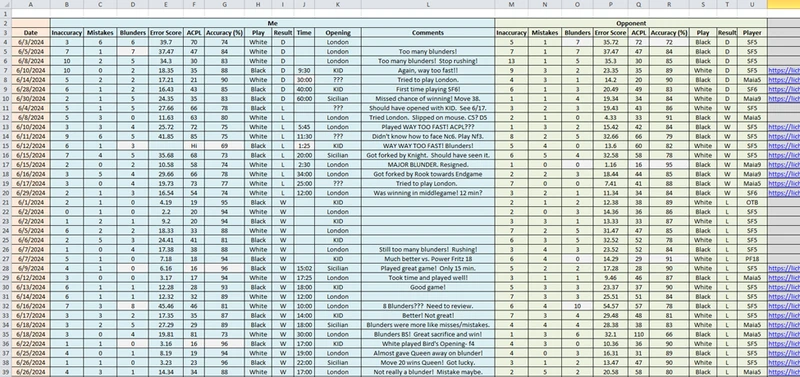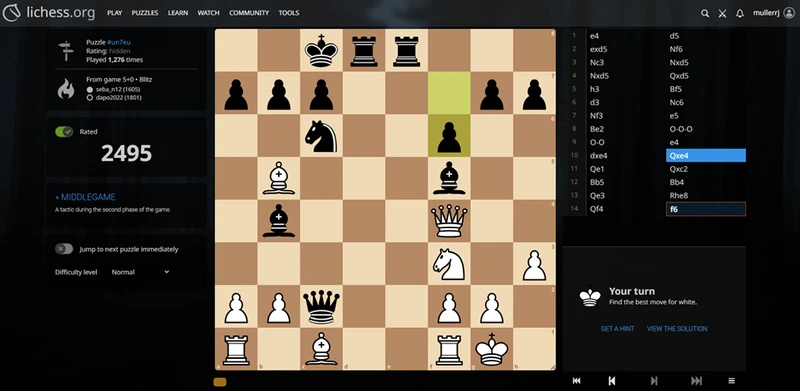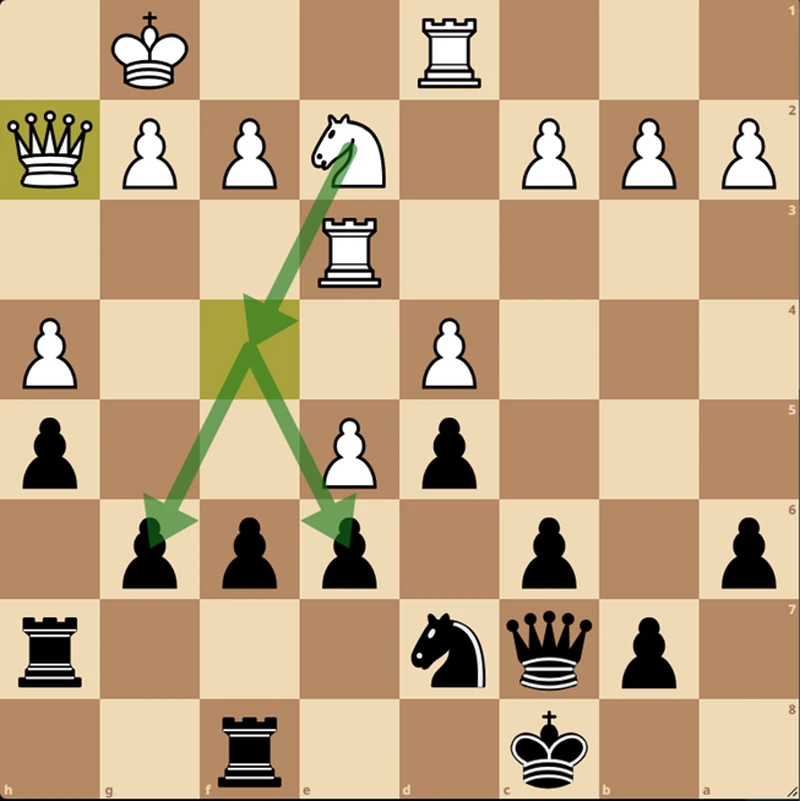
How to improve in chess- for beginners through intermediate!
What phase of the game do you need to improve upon?I’m guessing if you’re taking up chess for the first time, or you’re a beginner or intermediate who wants to get better, you’re looking for the best way to improve in chess. I know as an advanced intermediate, with an Elo of approximately 1750 on Lichess, I’m ALWAYS looking to improve.
But, what’s the best way to improve in chess? I think before we begin to answer this question, we MUST know what needs improving. What phase of the game? The opening, the middle game, the end game? Every phase of the game?
If you’re new to the game of chess (a beginner), the answer to the question is most likely: all phases of the game need to be improved. If that’s the case, the best (and easiest) way to improve is to continue to play as often as you can. That includes playing the Computer on Lichess (at the appropriate level), playing someone online on Lichess, or playing someone Over The Board (OTB) at a friend’s home, your local club or library. Additionally, since chess is comprised primarily of tactics, the best way to improve tactics is to solve chess puzzles daily. There’s a saying that "chess is 99 percent tactics". It’s obviously an exaggeration, but the point is: tactics are a very important part of the game. Chess puzzles will help you improve your tactics. If you’re a beginner, start with easy puzzles that cover all phases of the game.
I’ve been teaching elementary school kids how to play chess for over 3 years now. Many of the kids in my classes are either first-time players or relatively new to the game with limited experience. Most kids play chess with reckless abandon. That is, they play with complete disregard for potential consequences or risks. It’s not intentional or that they don’t care, they just don’t know any better. The best way to describe ‘kids play’ is that of a flickering light bulb. There are times where they play brilliantly (very bright), albeit not many times, and other times not at all...no brightness. It’s because they play with limited focus. Most of the time, the kids only focus on a specific area of the board and overlook other critical parts of the board. Or, they have a plan (like trying to execute the Scholar’s Mate, for example, on their opponent) with total disregard of their opponents plan. Kids also play carelessly. They make careless tactical errors or blunders. And, lastly, for whatever reason, kids rush when they play. They make hasty moves without thinking. They usually make the first move that they see, with little rhyme or reason to the move. The kids are normally allotted 25 minutes (total time) to play a game in class. If I had to guess, I’d say the majority of the games are finished/over in 15 minutes (total). That’s too fast for a beginner. I have to remind them, every class, to slow down and focus! The game of chess is not a race...unless of course you’re playing speed chess.
My advice to kids or beginners just learning the game, to avoid blunders, is to:
· Make sure there is a reason for their move, every move. Are the moves achieving the objectives in the opening: control the center, develop pieces and safeguard the king by castling?
· Consider/ evaluate your opponent’s moves. Are there any checks, captures or threats (CCT)?
· Take your time. Slow down. Don’t rush! Try to find the ‘best’ move, not just the ‘first’ move you see.
· Play as often as you can. Practice doesn’t make perfect in chess, but it helps.
· Solve chess puzzles as often as you can. As I said before, “chess is 99% tactics”. Well, almost! The best way to get better at tactics is by solving chess puzzles.
As an intermediate or advanced intermediate, the middle game is the phase of the game that normally needs the most improvement. It’s a fact that the majority of blunders in chess often occur during the middle game because it's the phase with the most tactical complexity, where players have developed their pieces, and the board is open, leading to a higher chance of overlooking tactical threats or miscalculating potential consequences of a move, especially when under time pressure.
I know the middle game is the phase of the game where I make the most blunders. In the last 100 games I played, I can tell you for a fact that 95% of my blunders occurred during the middle game. According to an excel spreadsheet I maintain from Lichess.org’s computer game analysis, I average approximately 2 blunders per game. And, when I blunder it normally occurs between my 15th to 20th move- which is clearly past the Opening and prior to the Endgame. Why is that? As I said, it’s because the middle game is the phase of the game that has the highest tactical complexity.
Here’s a screenshot of that spreadsheet I maintain showing the number of blunders per game in the games I played in the month of June. The blunder column (for me) is column D. Some games I play blunder-free. Other times I have/make several blunders. It’s hard to see, but on a couple games I had as many as 6-7 blunders. That’s way too many! The games I play blunder-free I normally win. Games where I make 2 or more blunders, I normally lose. Wins and losses also depends on the number of blunders my opponent makes. Usually, the person that blunders less is the winner! See my blog, “Err less and win more”: https://lichess.org/@/mullerrj/blog/err-less-and-win-more/hxZoock7

By the way, I highly recommend that you analyze your games after you play- particularly if/when you lose. You don’t have to generate a spreadsheet like I did, but you want to check periodically. In order to improve, you not only need to know ‘when’ you blundered, you want to know ‘why’ you blundered.
Here are the main reasons why I blunder during the middle game. Perhaps you do too:
-
Increased tactical complexity- Unlike the opening where moves are more structured, and the endgame where positions are often simplified, the middle game presents a wide range of tactical possibilities. It’s easier to miss a critical attacking sequence or defensive move during the middle game.
-
Piece activity- With most pieces developed, the middle game often involves active piece play, increasing the chances of overlooking a tactical opportunity or falling victim to a counter-attack. I’m guilty of both during the middle game: overlooking an opportunity and/or falling victim to a counter-attack by my opponent.
-
Time pressure- As the game progresses, players often face time pressure, which can lead to rushed decisions and missed tactical calculations, making blunders more likely. Of all the reasons I blunder during the middle game, this is probably the least likely reason for my blunders. That’s because most of the games I play have a time control of 30+5 and I’m rarely pressed for time. Having said that, I do rush at times believing my first candidate move is always the best move- when it’s not.
-
Decision-making complexity: The middle game requires players to make complex strategic decisions while also considering tactical threats, which can lead to errors if not carefully analyzed.
Now that we’ve identified where we blunder and how we blunder, the million dollar question is: how do we reduce/minimize these blunders so we can improve? As intermediate players we’re most likely never going to completely eliminate blunders, on average, so we must strive to reduce them. I’d say a good goal of mine would be to reduce the number of blunders per game from 2 to 1. It doesn’t seem like much, but that would be a great improvement. By the way, it’s not to say that I don’t occasionally play blunder or mistake free. Here’s a game I played the other day, perhaps the best game I played in a while, that was both blunder free and mistake free. Granted, it was against Lichess Stockfish 5 that plays to approximately a 1700 Elo rating. I played the Caro-Kann defense with the black pieces: Stockfish level 5 vs mullerrj: Caro-Kann Defense: Two Knights Attack, Mindeno Variation, Exchange Line • lichess.org
Here’s how to reduce/minimize blunders so you can improve:
· Practice tactics regularly- Sharpening your tactical skills through practice puzzles/problems helps you identify and calculate tactical threats more effectively. Since most of my blunders are during the middle game, I change the puzzle theme on Lichess to “Middle Game”. I recommend you do the same.

Note: when choosing chess puzzles to solve, try to choose ones that are ‘middle game’ oriented and more difficult to solve. They will help you the most. If you’re concerned about your Lichess puzzle rating, you can always toggle the ‘Rated’ switch OFF.
· Slow down and analyze- Take your time to carefully consider your options and visualize the potential consequences of each move before making a decision. This is especially important during the middle game. Examine multiple candidate moves and make the best one. If you see a good move, look for an even better one. You’d be amazed at the number of better moves you miss during a game. I know I miss a bunch.
· Look for key tactical motifs- Familiarize yourself with common tactical patterns like forks, pins, and discovered checks to quickly identify potential threats. Don’t just look for key tactical motifs for you to make, look at one’s your opponent is about to make. I can’t tell you the number of times I get a major piece of mine pinned, by my opponent, during the middle game. These key tactical motifs are critical during the middle game.
· Play prophylactic moves- A prophylactic move in chess is a move or series of moves that a player makes to prevent their opponent from taking action. The goal of a prophylactic move is to improve a player's position and restrict their opponent's ability to improve theirs. Anticipate your opponent's threats and make moves that prevent them from creating dangerous situations.
Here’s a game I played just the other day, where I should have played a prophylactic move. We were at equal strength and this was the 20th move of the game. I was playing the black pieces and I overlooked white’s knight play Nf4 on its next move, forking both of my black pawns.

I could/should have played a prophylactic move, prior to white’s move, such as g5 or fxe5, to prevent the white knight from forking my pawns- and preventing future threats on my rooks or queen. It was a close game, but I eventually lost this game in a pawn endgame.
Note: the source for much of this blog is from Google AI.
You may also like
 mullerrj
mullerrjThe benefits of electronic chess boards (eBoards)
How electronic chess boards can improve your game andreagobbez
andreagobbezDeep Learning Self-Play - Bot journey!
Deep Learning is a self-learning algorithm that you can put a model on training to make it find patt… mullerrj
mullerrjIf you want to improve in chess, stop playing on your computer!
This blog is intended for beginner through intermediate chess players playing Classical chess. CM loristavernier
CM loristavernierWhat should you eat to improve at Chess ?
I'll explain to you what I was doing right and wrong with my food during my chess tournaments. GM NoelStuder
GM NoelStuderI won 200 rating points with a simple challenge
At the end of July, I set myself a challenge: 30 days, each day 6 games of 3+2 Blitz with full focus. WFM fla2021
WFM fla2021